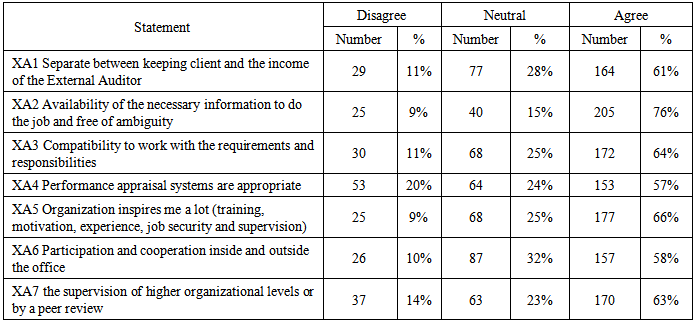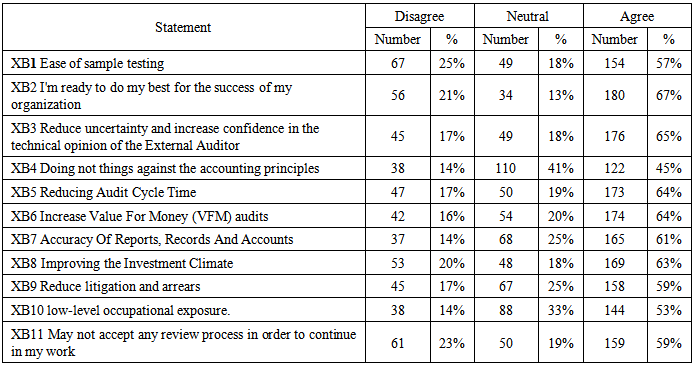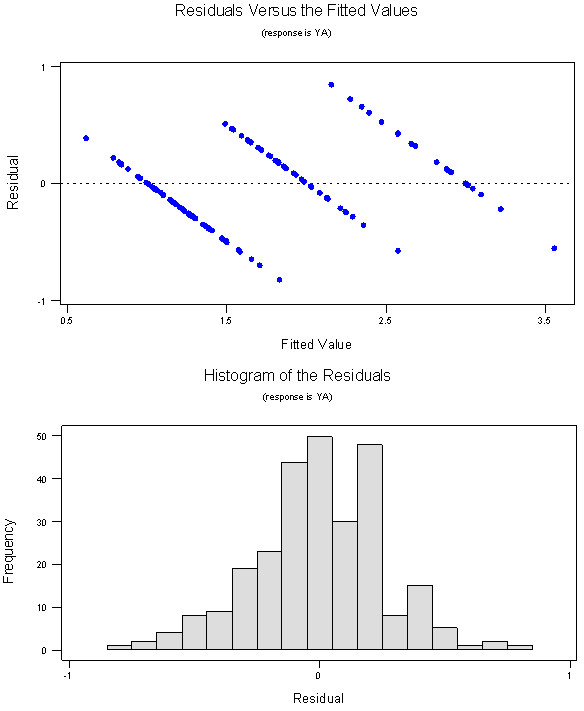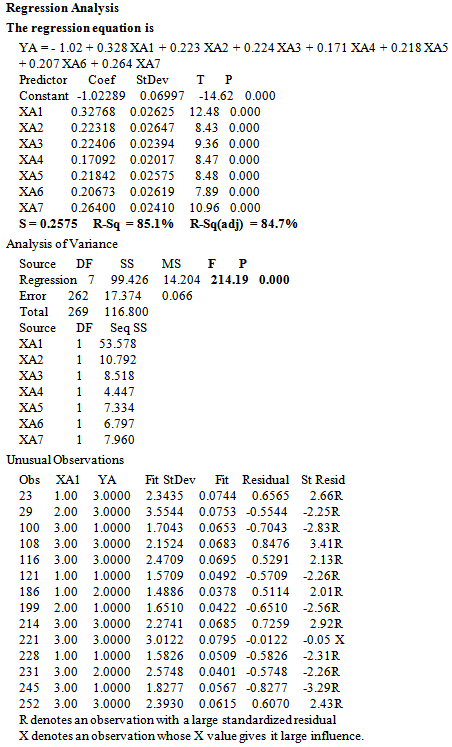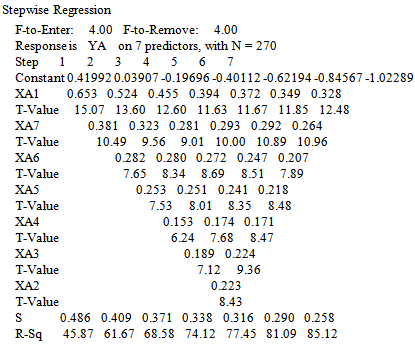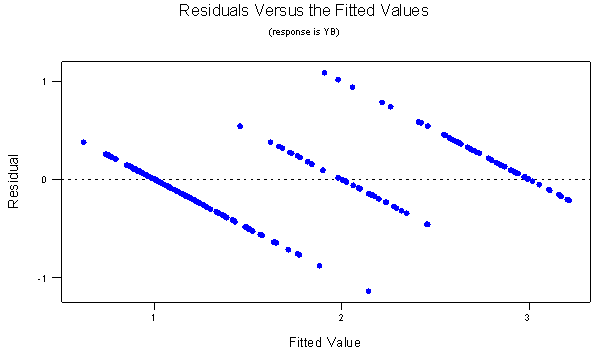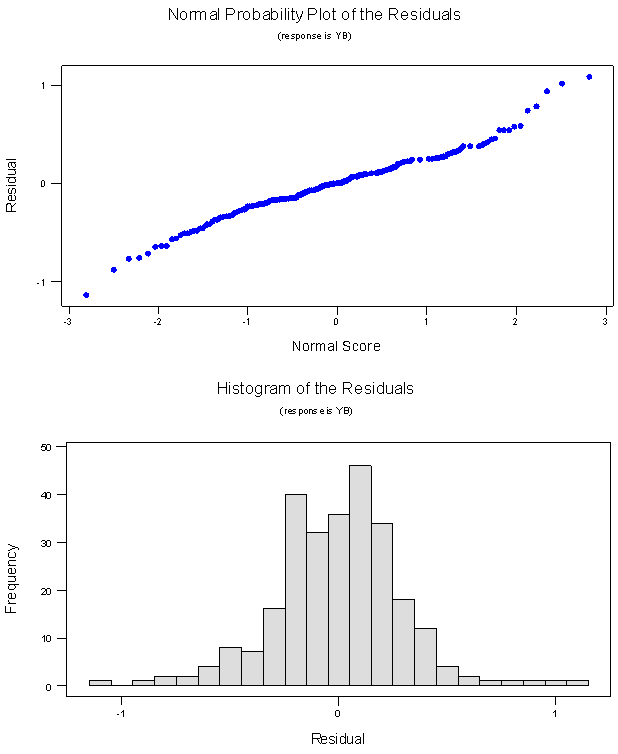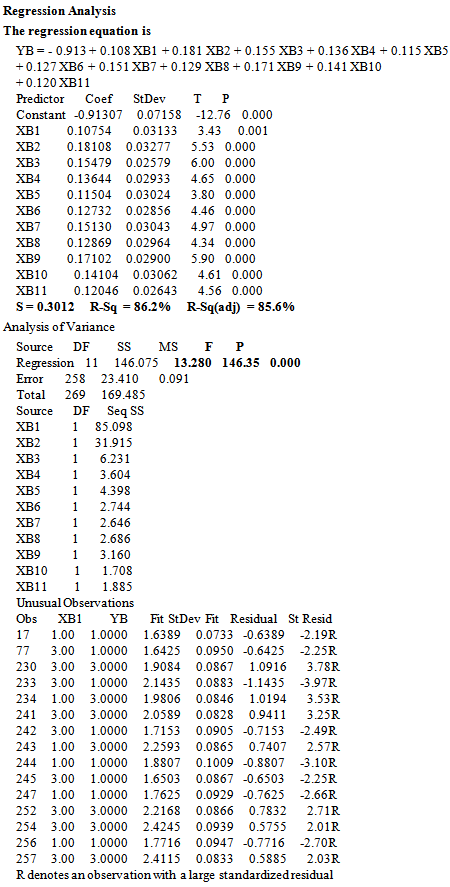-
Paper Information
- Paper Submission
-
Journal Information
- About This Journal
- Editorial Board
- Current Issue
- Archive
- Author Guidelines
- Contact Us
International Journal of Finance and Accounting
p-ISSN: 2168-4812 e-ISSN: 2168-4820
2015; 4(6): 311-323
doi:10.5923/j.ijfa.20150406.01

The Effect of Control Variables of Job Satisfaction and Organizational Citizenship on the Performance of External Auditor (Field Study in Saudi Arabia)
Azza H. Shalaby
College of Business Admiration
Correspondence to: Azza H. Shalaby, College of Business Admiration.
| Email: |  |
Copyright © 2015 Scientific & Academic Publishing. All Rights Reserved.
This work is licensed under the Creative Commons Attribution International License (CC BY).
http://creativecommons.org/licenses/by/4.0/

This research is aimed to study the effect of Job Satisfaction and Organizational Citizenship on the Job performance of the External Auditor. Data was collected through questionnaires distributed to a random sample of workers in the Capital Companies, and Audit Offices in Jeddah and Riyadh, two major cities of Saudi Arabia. The study utilized descriptive analysis, simple correlation and Linear regression, as the statistical methodology to illustrate the relationships among variables. Results obtained support the interrelation among variables. Although there is controversy in the quantity of the relationship among the variables IE., job satisfaction, Organizational Citizenship and job performance, existing research has provided evidence that a positive relationship exists between these variables: job satisfaction, Organizational Citizenship and job performance. The goal of this study is to strengthen and expand the previous findings by evaluating the interrelationship among all the three variables: job motivation, job satisfaction, and job performance and the combined effects among them in audit office. And thus increase the Job Performance of the External Auditor.
Keywords: Job Satisfaction, Organizational Citizenship, Job
Cite this paper: Azza H. Shalaby, The Effect of Control Variables of Job Satisfaction and Organizational Citizenship on the Performance of External Auditor (Field Study in Saudi Arabia), International Journal of Finance and Accounting , Vol. 4 No. 6, 2015, pp. 311-323. doi: 10.5923/j.ijfa.20150406.01.
Article Outline
1. Introduction
- The research faces a problem to study the reflection of some variables of Job Satisfaction and Organizational citizenship, which interact dynamically with each other and their impact on the job Performance of the External Auditor through field study in Saudi Arabian milieu. An individual may find himself a party to a large number of bilateral relations in which he plays one of the two roles, Perhaps one of the parties may impose pressure and control the other side, or the respondent party that is subject to the pressure adjusts its behavior according to the dictate of the other party. (Abdul Latif, 1997).The relationship to Organizational Citizenship between the individual and his work is the relationship between the auditor and the audit office. The person who is loyal to his organization will exert his highest effort to help his organization to achieve its success (Sheishaa, 1998). Therefore, the ignorance of this study and the ignorance of the analysis of these variables leads to the creation of varying degrees of organizational citizenship, which leads to varying degrees of accuracy on the job performance of the external auditor, and then leads to some fundamental error threatening the audit profession such as lump appreciation, and wasted ledgers (Somia, 2003). Therefore, it requires a study of these variables - Job Satisfaction, Organizational citizenship, and its impact on the Job Performance on the External Audito.
2. Purposes and Significance of the Study
- Based on the above introduction, this study aimed to illustrate the impact of variables of job satisfaction and, Organizational citizenship - combined - on the job performance of the external auditor.
3. Questions about the Study
- The study has one question that has been generated for the purposes, whichIs: What is the effect of the relationship between the variables of job satisfaction and, Organizational citizenship, combined with the performance of the external auditor?
4. Literature Review
- Analytical study, Cranny et al (1992) indicated that it is all about reactions of the employees good or bad which are the results of comparison of actual and desired results. To demonstrate Literature Review multifaceted argument among writers which concentrated mainly on two trends:The first trend: Job Satisfaction causes Organizational Citizenship and vice versa. Khatab, (1988) considering Organizational Citizenship as dependent variable, and job satisfaction as independent variable. As Eslami, Gharakhani, (2012) studies indicate that all three factors of Job satisfaction (Promotions‚ Personal relationships‚ and Favorable conditions of work) have positive and significant effects on Organizational Citizenship. According to Jacob it is possible though that people who perform with better feel, more satisfied with their jobs as a result Jacob &Soloman, (1977).Job Satisfaction is a major factor to enhance and maintain the overall yield of organization and the job loyalty by efficient service and better performance. Many researchers have created the links between job satisfaction and other factors like stress and burnout, motivation, turnover intention workplace environment, organizational commitment, empowerment, performance, turnover intention and personal characteristics. (Chen, 2006; Fair brother and Warn, 2003; Furnham et al., 2002; Gaertner, 1999; Ghiselli et al., 2001; Jernigan et al., 2002; Karatepe et al., 2006; Lam et al., 2001; Linz, 2003; Silva, 2006; Spence Laschinger et al., 2002; Tepeci and Bartlett, 2002; Tsigilis et al., 2004) .Also Many studies show that job satisfaction is also associated with OCB a willingness to go beyond formal job requirements in order to help coworkers and / or organization, including (Borman, et al, 2001; Ilies, Scott & Judje, 2006; Moorman, & Byrne, 2005; and Organ, Podsakoff & Mackendzie, 2006). But some studies show the positive correlation between job satisfaction and performance makes sense and though a correlation alone can’t confirm that satisfaction is causing good performance, it is certainly consistent with that conclusion including (Harrison, Newman & Roth, 2006).While (Rafael, 2005) shows the relation between the characteristics of the job performed and the level of subjective satisfaction of workers, the results do not support the use of job satisfaction as a measure of job quality. But he discusses the different processes that could explain the coexistence of wide variations in job quality with high overall levels of job satisfaction. (Rafael, Enrique, 2005). According to Chaiburu et al, it is difficult to determine whether job satisfaction caused increased Organizational Citizenship behavior or whether engaging in OCB caused increased job satisfaction, further OCB may reflect factors other than job satisfaction such as personality characteristics (Chaiburu et al, 2008). The researcher believes it is also easily imagined that there are a lot of auditors loyal to their offices, and their Organizational goals, but at the same time, they feel dissatisfied with their positions in the organization and vice versa. Some cases of OCB might occur as a part of a strategy designed to get a pay raise or promotion or reach some other personal goal. In one study, for example, employees who believed it would help their chances for promotion engaged in high levels of OCB before being promoted then reduces their OCB afterward (Hui, Lam & Law, 2000). Finally, the researcher believes that we can imagine there are some Auditors, who are satisfied with their jobs, but they feel no loyalty to the organization and their performance is weak. It also easily imagines the existence of some auditors loyal to an organization, and they believe in the Organizational goals, and their desire to stay working as part of the organization, and to exert their maximum effort for this organization effectively.The second trend: Any causal relationship between job satisfactions and organizational Citizenship takes the form of a closed circuit. According to Ashoosh (1996) the Organizational Citizenship as a result of partial job satisfaction and Organizational Citizenship is a reason for more job satisfaction, including (Alkhthelh, 1997; Omari, 1998; and Lozi, 1999). Although according to Hui some cases of OCB might occur as a part of a strategy designed to get a pay raise or promotion or reach some other personal goal. The researcher claims in one study, for example, employees who believed it would help their chances for promotion engaged in high levels of OCB before being promoted then reduces their OCB afterward (Hui, Lam & Law, 2000). And, further OCB may reflect factors other than job satisfaction such as personality characteristics. Generally, people who are satisfied with their jobs tends to be more motivated, work harder and performed better than employees who are dissatisfied. Existing research has provided evidence that a positive relationship exists among job satisfaction, Organizational Citizenship and job performance. The goal of this study will be to strengthen and expand the previous findings by evaluating the interrelationship among all three variables, and the combined effects of job satisfaction, Organizational Citizenship on job performance in audit office. So, this field study reveals many predictor variables that affect job satisfaction, Organizational Citizenship and job performance in audit office. 4.1. Motivation, Reward and recognition prove key factors, which influence the employee job satisfaction (Jun et al., 2006). Cronin and Becherer (1999) emphasized that there is a significant relation between reward and recognition and Job satisfaction as studies conducted on nurses. Helms (2006) emphasized that extrinsic reward such as money and promotions are motivating factors for employees. To cite an example, has a strong influence in creating a job satisfaction phenomenon among workers (Sheishaa, 1998). When suitable incentive scheme is linked to achieving a particular result, it will stimulate audit performance while some studies have proposed a simple economic framework within which to explain the puzzles (Pugno & Depedri, 2009). The key idea behind this framework is that intrinsic motivations and self-esteem help explaining both job satisfaction and job performance. The employer can thus adopt other, more friendly actions, besides using incentives and controls to enhance performance of the employees. (Piano, Depedri, 2009).The researcher believes that the compatibility between the individual and the job leads to job satisfaction. And the role of ambiguity is to lead to a lower job satisfaction. And the available alternative to them is to move to other organizations. Another study examined also refers to the effects of employee's self-enhancement motives on job performance behaviors (organizational citizenship behaviors and task performance) and the value of these behaviors to them. The results from a sample of 84 working students indicate that role ambiguity moderated the effects of self-enhancement motives on job performance behaviors and that managerial perceptions of an employee’s commitment moderated the effects of those organizational citizenship behaviors that are aimed at other individuals on managers’ reward allocation decisions (Yun, Takeuchi, Liu, 2007). According to (Aziri, 2011) Job satisfaction represents one of the most complex areas facing today’s managers when it comes to managing their employees. Porter and Steers (1973) argued that job satisfaction reflects the aggregate level of net worker's prospects and they remain loyal to their jobs. Employees want some other benefits along with their jobs like promotion, pay, autonomy, etc. These benefits and range of their preferences may be different for every job, but if these benefits remain unmet then their satisfaction level will decline and lead to the withdrawal behavior.Many studies have demonstrated an unusually large impact of the job satisfaction on the motivation of workers, while the level of motivation has an impact on both productivity, and performance of business organizations. There is a considerable impact of the employees' perceptions of the nature of his work and the level of overall job satisfaction. Financial compensation has a great impact on the overall job satisfaction of employees. 4.2. Participation is also another factor which is playing a big role in influencing the formation of common working including internal and external users on differences, it will also have affiliation with the objectives of their organizations in effective and efficient manner (Glisson, Mark, 1988) (Cotton et al., 1988, p. 17). It is very important to note that employee like to participate in decision making and this participation lead to job satisfaction. Participation in decision making fulfills the need of employees ego and employee behavior will be more cooperative towards organizational objectives and goals. The previous research shows that job satisfaction, increase due to participation in decision making.According to (Wagner, 1994), there is a relationship between participation in decision making and how they influence on job satisfaction.Luthans, (2005), give a statement in his research shows that when the employee participate in their decision making level of absenteeism, decreased, improved performance, organizational commitment greatly improved and job turnover decreases, whether job satisfaction increased. Besides, their ability to connect well with each other and among the beneficiaries of the service -such as tax advisor-, influence them and convince them, the main stalk is the service beneficiaries' perception of the auditors' independence (Radi, 1999) Where auditor's reputation is affected by bearing the burden of litigation fees. As a result, there is a negative impact on organizational citizenship on the individual's job performance and in return affects the productivity of the organization and the independence of the auditor himself.4.3. Audit fees which depend on certain results, such as maintaining the audit client, or the profitability of the office, are biased, non-objective and having many risks such as fee litigation, losing the client, race to the bottom strategy among auditors for audit fees (Gray, 1994), the researcher agrees with the result that the employor is willing to work in that organization, he try their best for the success of the organization and he think to do work in that organization it is the best option for him. He decided not to leave and nor any plan to go in some other organization It is just like a behavior of citizenship who tries to increase the value of the firm, its image as well as develop an interest in outsiders mind.4.4. Supervision and control have a significant impact on creating a level of satisfaction and organizational citizenship. These supervisors who occupy upper Organizational levels and who are supervised by Assistant-peer- partner of the office have a better ability to supervise. (Ralph, Scandura, 1991). Thus encouraging supervisory results in a strong correlation between supervision and regulatory control of job performance. The results of several previous studies have established a relationship between job satisfaction and job performance. And, the goal of this study will be to strengthen and expand the previous findings by evaluating the interrelationship among all variables of organizational citizenship, job satisfaction and job performance in the audit office through a field study.
5. Hypotheses of the Study
- Based on the literature review and research objectives, the following hypotheses were derived are as follows:H1: There is no relationship between the variables of Organizational Citizenship and Job satisfaction combined (independent variable) on the Job performance of the external Auditor (dependent variable).H2: The Alternative Hypothesis:- There is a relationship between the variables of Organizational Citizenship and Job satisfaction, combined (independent variable) on the Job performance of the external Auditor (dependent variable).The researcher will test the hypothesis researches through field study.
6. The Field Study
- The field study aims to explore the common points of views in the study about the impact statement professional and Organizational variety of job satisfaction and organizational citizenship, on the external auditor, In light of the problem, the importance of this research and to achieve its objectives.
6.1. Research Methodology
- This study will be designed using a correlation framework and employ a survey through a questionnaire, in a common format in terms of the contents of the questions from different Audit firms of Jeddah and Riyadh in Saudi Arabia. The questionnaire was distributed among big and middle levels of different firms. Both inferential and differential statistical methods were used the results of this study will be carried out through statistical calculations, making use of both the Pearson r technique and regression methods for measuring correlations.
6.2. Data Collection and Sample
- The present study employs a questionnaire survey approach to collect data for testing the research hypotheses. All independent and dependent variables require five-point Likert style responses ranging from “strongly disagree” to “strongly agree”. A survey is conducted on 270 Auditors. Data are analyzed using principal components analysis and relationships are tested using linear regression.The majority of this sample of male, due to the long working hours and the nature of the community and the most of the respondents has higher education, qualifications, skills, knowledge and experience as to help facilitate data collection, and reduce the risk of measurement errors.
|
6.3. Collect, Dump and Analysis Questionnaire List
- The researcher has divided the questionnaire into a set of queries relating to the problem of search (Job Satisfaction, Organizational Citizenship, and Job Performance) with a group inquiries regarding testing hypothetical Search.1 - Inquiries relating to research range.The effects of the variables on Organizational Citizenship and Job satisfaction representing 69%, while the effects of the Organizational Citizenship and job satisfaction on the performance of the External Auditor collectively representing 70%.
|
|
6.4. The Results of Statistical Analysis Using Linear Regression and Step Wise and Spearman Coefficient
- Using Minitab software and also using Spearman coefficient was calculated to illustrate the link between the professional and Organizational variables.First
|
|
6.5. Analysis the Results
- These findings indicate that Employees would achieve a higher level of Continuance Citizenship if the company has well-improved Promotions, Personal relationships and Favorable conditions of work. Accordingly, this states that Components of job satisfaction are positively related to Continuance citizenship. And also have significant effects on organizational citizenship. Accordingly, the results support the second Hypothesis.
7. Conclusions the Findings and Recommendations
- The Importance of professional and Organizational variables affecting and affected by each other positively or negatively, job satisfaction and Organizational Citizenship and job performance of external auditor takes the form of a closed circle or a vicious circle, and the integration of the needs of all parties has an impact in raising performance and increase the efficiency of workers, which ends to increase Organizational Citizenship effectiveness.The practical implication of the results indicates the critical roles of Components of job satisfaction have positive and significant effects on organizational citizenships and vice versa.-There is a direct relationship or strong positive correlation between Organizational Citizenship and job satisfaction (independent variables) and the JOB performance of the external auditor (dependent variable)., where the value of R = 0.698**There is a Relationship between job satisfaction and job performance would be positive if the organization provides different opportunities such as learn, grow and clear established career path. There is a strong correlation between Organizational Citizenship and job performance based on these variables, recognition and rewards, working conditions, relationship with supervisor teamwork.Job satisfaction and Organizational Citizenship have a positive impact on the job performance of the external auditor On the basis of these values honesty, trust, respect for others etc..− Should study and analysis of all the variables affecting the Organizational Citizenship, which represents an integrated system to create the highest level Organizational Citizenship, and develop strategies to improve the JOB performance of the external auditor.− Replacing all the variables affecting the Organizational Citizenship in order to increase citizenship to the application of these variables in an attempt to achieve compatibility or narrow the discrepancy between the external auditor and the audit office.
Appendix
References
| [1] | Lozi, Moses, OD: the fundamentals and concepts of modern, The first edition, Dar Wael for publication, Amman, Jordan., 1999. |
| [2] | Cranny, C.J., Smith, P.C., and Stone, E.F. (1992). Job Satisfaction: How People feel about their Jobs and how it affects their Performance. Lexington Books, New York. |
| [3] | Luthans, F. (2005). Organisational Behavior (10th Ed). New Yolk, McGraw-Hill Irwin. |
| [4] | Abdul Latif, A., Mohammed, Organizational commitment and its relationship to job satisfaction and job performance, economic and business review, Ain Shams University, faculty of commerce, 1997, pp 825. |
| [5] | Abu Sheishaa, I. Mokhtar, Restructuring of the relationship between organizational variables in the process of auditing and professional affiliation in order to increase the efficiency of the performance of the Auditor, economic and business review, Ain Shams University, faculty of commerce, volume no. 1, January 1998, pp 76-92. |
| [6] | Ali, A. Somia, The impact of providing information to the external auditor on the expectations of external users' awareness of its duties, Accounting Management & Insurance Review, Cairo University, Faculty of Commerce, volume 62, p. 34.2003 |
| [7] | Alkhthelh, M. Hand, Sources of job stress as perceived by employees in higher education, Journal of King Saud University, King Saud university, Faculty of Education and Islamic Sciences, volume no 9. 1997, pp 85-112. |
| [8] | Ashoosh, A. Mohammed, Organizational commitment and its relationship to job satisfaction and job performance and demographic characteristics of the labor force, a comparative study. Economic and business review, Ain Shams University, faculty of commerce, volume no 1, 1996, pp 835. |
| [9] | Borman, W. C., Penner, L., Allen, T., & Motowidlo, S. (2001). Personality predictors of citizenship performance. International Journal of Selection and Assessment, 9, 52-69. |
| [10] | Broken AZIRI., Job Satisfaction: A LITERATURE REVIEW Management Research and Practice, VOL. 3 ISSUE 4 (2011) PP: 77-86. |
| [11] | Chiaburu, D. S., & Harrison, D. A. (2008). Do peers make the place? Conceptual synthesis and meta-analysis of coworker effects on perception, attitudes, OCBs, and performance, Journal of Applied Psychology, 93, 1082–1103. Do: 10.1037/0021-9010.93.5.1082. |
| [12] | Chen, C.F. (2006), “Short report: job satisfaction, organizational commitment, and flight attendants’ turnover ıntentions: a note”, Journal of Air Transport Management, Vol. 12, pp. 274-6 |
| [13] | Cotton, J.L., Vollrath, D.A., Froggat, K.L., Lengnick-Hall, M.L. And Jennings, K.R. (1988), “Employee participation: diverse forms and different outcomes”, Academy of Management Review, Vol. 13 No. 1, pp. 8-22. |
| [14] | Fairbrother, K. And Warn, J. (2003), “Workplace dimensions, stress and job satisfaction”, Journal of Managerial Psychology, Vol. 18 No. 10, pp. 8-21 |
| [15] | Gaertner, S. (1999), “Structural determinants of job satisfaction and organizational commitment ın turnover models”, Human Resource Management Review, Vol. 9 No. 4, pp. 479-93. |
| [16] | Glisson, C. & Mark, D., (1988), “Predictors of Job satisfaction and Organizational Citizenship in Human service Organizations, administrators, e science Quarterly, Vol. 33, No., /1-167, March, pp 61/81. |
| [17] | Harrison, D. A., Newman, D. A., & Roth, P. L. (2006). How important are job attitudes? Meta-analytic comparisons of integrative behavioral outcomes and time sequences. Academy of Management Journal, 49, 305–325. |
| [18] | Helms, M. M. (2006)."Theory X and Theory," Encyclopedia of Management Education. Retrieved. |
| [19] | Hui, C., Lam, S. S., & Law, K. K. (2000). Instrumental values of organizational Citizenship behavior for promotion: A field quasi-experiment. Journal of Applied Psychology, 85, 822–828. |
| [20] | Ilies, R., Scott, B. A., & Judge, T. A. (2006). The interactive effects of personality traits and experienced states on intra-individual patterns of citizenship behavior. Academy of Management Journal, 49,561-575. |
| [21] | Jacobs, R., & Solomon, T. (1977). Strategies for enhancing the prediction of job performance from job satisfaction.. Journal of Applied Psychology, 62, 417-421. |
| [22] | Javad Eslami and Davood Gharakhani, Organizational Commitment and Job Satisfaction, ARPN Journal of Science and Technology, VOL. 2, NO. 2, March 2012. |
| [23] | Jernigan, I.E., Beggs, J.M. and Kohut, G.F. (2002), “Dimensions of work satisfaction as predictors of commitment type”, Journal of Managerial Psychology, Vol. 17 No. 7, pp. 564-79. |
| [24] | Karatepe, O.M., Uludag, O., Menevis, I., Hadzimehmedagic, L. and Baddar, L. (2006), “The effects of selected ındividual characteristics on Frontline employee performance and job satisfaction”, Tourism Management, Vol. 27, pp. 547-60. |
| [25] | Khatab, S., Aida, Organizational commitment and job satisfaction, a field study on Saudi women worker, Journal of Administrative Sciences, King Saud University, AD 13 (1), p. 33, 1988. |
| [26] | Lam, T., Zhang, H. And Baum, T. (2001), “An investigation of employees” job satisfaction: the case of hotels in Hong Kong”, Tourism Management, Vol. 22 No. 2, pp. 157-65. |
| [27] | Linz, S.J. (2003), “Job satisfaction among Russian workers”, International Journal of Manpower, Vol. 24 No. 6, pp. 626-52. |
| [28] | Radi, S., Mohammed, the expectations gap in auditing: Diagnosis and solutions, critical study, Journal of College of Commerce of Scientific Research, Faculty of Commerce, Alexandria University, First Issue, March, pp. 734, 1999. |
| [29] | Rafael Mu˜noz de Bustillo Llorente, Enrique Fern´andez Mac´ıas, (2005) Job satisfaction as an indicator of the quality of work, The Journal of Socio-Economics, 34 ,656–673. |
| [30] | Seokhwa Yun, Riki Takeuchi, and Wei Liu, (2007) Employee Self-Enhancement Motives and Job Performance Behaviors: Investigating the Moderating Effects of Employee Role Ambiguity and Managerial Perceptions of Employee Commitment, Journal of Applied Psychology, Vol. 92, No. 3, 745–756. |
| [31] | Silva, P. (2006), “Effects of disposition on hospitality employee job satisfaction and commitment”, International Journal of Contemporary Hospitality Management, Vol. 18 No. 4, pp. 317-28. |
| [32] | Spence Laschinger, H.K., Finegan, J. And Shamian, J. (2002), “The impact of workplace empowerment, organizational trust on staff nurses “work satisfaction and organizational commitment”, Advances in Health Care Management, Vol. 3, pp. 59-85. |
| [33] | Tepeci, M. And Bartlett, A.L.B. (2002), “The hospitality industry, culture profile: a measure of individual values, organizational culture, and person-organization fit as predictors of job satisfaction and behavioral intentions”, Hospitality Management, Vol. 21, pp. 151-70. |
| [34] | Trompeter, gray, (1994), “The Effect of Partner Compensation Sgemes and generally accepted accounting principles on audit partner's judgment”, Auditing: A journal of practice & Theory, Fall, pp. 56/68. |
| [35] | Tsigilis, N., Koustelios, A. And Togia, A. (2004), “Multivariate relationship and discriminant validity between job satisfaction and burnout”, Journal of Managerial Psychology, Vol. 19 No. 7, pp. 666-75 |
| [36] | Viator, Ralph and Terri Scandura (1991) “A study of Mentor –Protégé Relationships in large Public Accounting Firms “, Accounting Horizons, September, pp. 20/30. |
| [37] | Wagner, A.J. 1994. “Participation’s effects on performance and satisfaction: A reconsideration of research evidence, Academy of Management Review”, Vol. 19, pp. 312–30. |
| [38] | Cronin SN, Becherer D. (1999), Recognition of staff nurse job performance: staff and manager perceptions. J NursAdm, Jan;29(1):26-31. |
| [39] | Ghiselli, R.F., La Lopa, J. and Bai, B. (2001), “Job satisfaction, life satisfaction and turnover ıntend among food service managers”, Cornell Hotel & Restaurant Administration Quarterly, April, pp. 28-37. |
| [40] | Furnham, A., Petrides, K.V., Jackson, C.J. and Cotter, T. (2002), “Do personality factors predict job satisfaction?” Personality and Individual Differences, Vol. 33, pp. 1325-42. |
| [41] | Maurizio Pugno and Sara Depedri, Job performance and job satisfaction: an integrated survey, Dipartimento DI Economia, Università degli Studi DI Trento, Discussion Paper, No. 4, 2009. |
| [42] | Moorman, R. H., & Byrne, Z. S. (2005). How does organizational justice affect organizational citizenship behavior? In: J. Greenberg, & J. Colquitt (Eds.), Handbook of organizational justice, (pp. 355-380); Mahwah, NJ, US: Lawrence Erlbaum Associates. |
| [43] | Omari, A., Obaid, Determinants of organizational Commitment in the public health sector, Research Centre 74, King Saud university, Faculty of Arts, 1998. |
| [44] | Organ, D. W., Podsakoff, P. M., & MacKenzie, S. B. (2006). Organizational citizenship behavior: Its nature, antecedents, and consequences. Thousand Oaks, CA: Sage. |
| [45] | Porter, L.W. And Steers, R.M. (1973). Organizing Work and Personal Factors in Employee Turnover and Absenteeism, Psychological Bulletin, 80, 151-176. |
 Abstract
Abstract Reference
Reference Full-Text PDF
Full-Text PDF Full-text HTML
Full-text HTML

